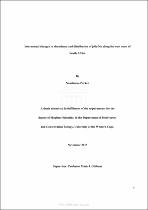Interannual changes in abundance and distribution of jellyfish along the west coast of South Africa
Abstract
Hydromedusae are mostly carnivorous planktivores that under ideal conditions can reproduce and accumulate to form dense masses of jellyfish, known as blooms. These jellyfish blooms may have various impacts on their surrounding biota and in severe cases have the potential to result in ecosystem-wide changes. This study investigated assemblages of hydromedusae within the southern Benguela ecosystem, between the years 2000 and 2006. The samples analyzed were collected as part of routine Spawner Biomass Surveys conducted by the
Department of Environmental Affairs: Ocean and Coasts (previously Marine and Coastal Management) using Bongo nets. Two hundred and forty two of the samples collected during the spring months, October and November, were analyzed. Environmental variables including (amongst others) sea surface temperature (SST), sea surface salinity (SSS), sea surface oxygen (SSO) and fluorescence (as a proxy for Chlorophyll a concentration) were measured to observe their influence on medusoid assemblages, distribution, abundance and diversity. Assemblages of hydromedusae were represented by 69 species and were dominated by
Siphonophora and Leptomedusae. Mean abundance of hydromedusae were highest in 2005 (3.15 ind.m-³, SD 3.21) and lowest in 2002 (0.50 ind.m-³, SD 0.70). Trends in abundance displayed a general bell-shaped curve relationship with SST. The random-effects meta-analysis model revealed, across all years and all medusaoid classes that SSS (R=0.469), latitude (R=0.223), bottom fluorescence (R=0.533), mean fluorescence (R=0.338) and volume filtered (R=-0.408) were all significant factors in driving medusoid abundance at p<0.05. Medusoid diversity
displayed a positive correlation to both temperature and salinity. A BIOENV analysis was used to explore the environmental factors that best described the variation observed in the biological assemblages. The results from this analysis suggest that SSS and bottom oxygen (BO) are the environmental factors that most influence the composition of medusoid assemblages.

